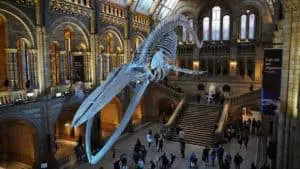Celtic Goddesses and Their Stories: Unveiling Mythical Matriarchs
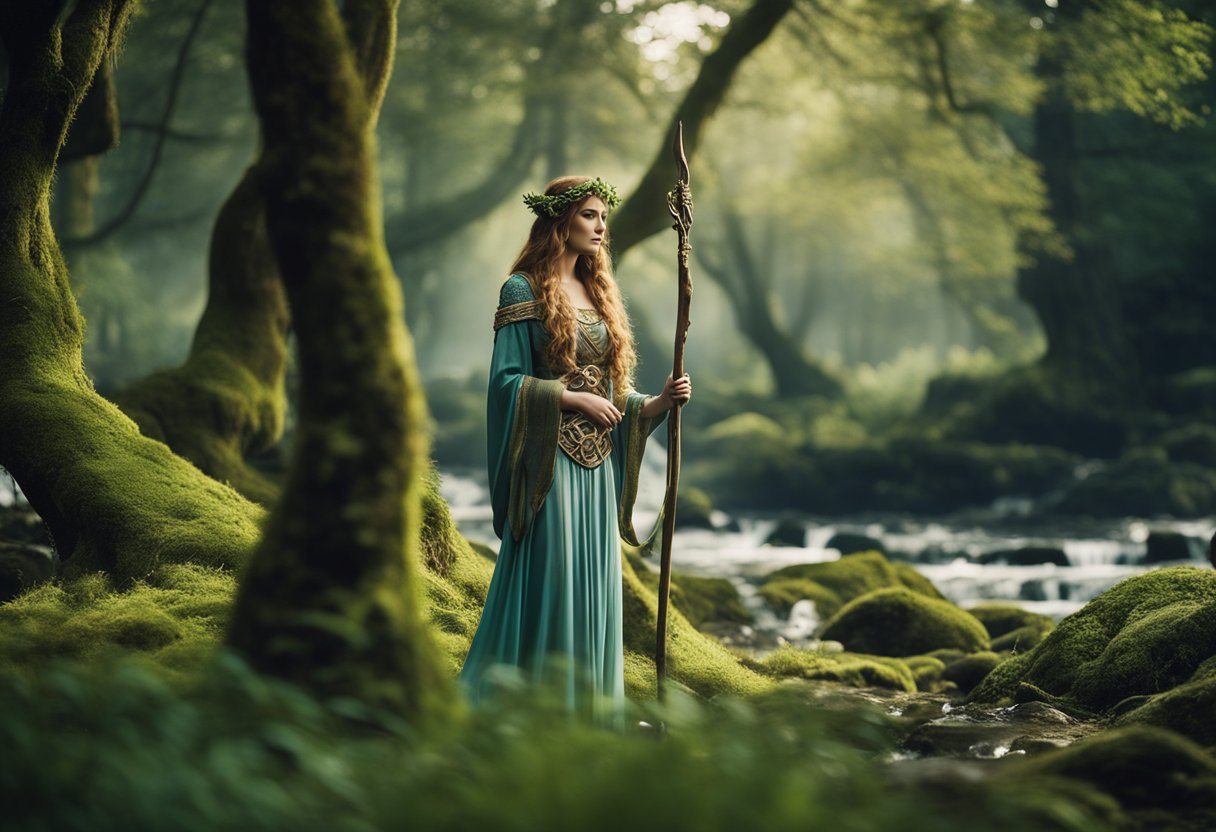
Updated On: April 22, 2024 by Panseih Gharib
Celtic mythology is steeped in stories of powerful Celtic goddesses who played vital roles in the lives and culture of ancient Celtic people. These divine figures were often associated with aspects of nature, sovereignty, and the cycle of life and death. Each deity had her own unique attributes and stories, influencing everything from seasonal festivals to the artistic expressions found in Celtic artefacts.

The tales of these goddesses permeate through Irish, Welsh, and other Celtic cultures’ sagas and mythologies, reflecting the Celts’ deep connection with the natural world and their belief in the power and presence of the feminine divine. Their legends have been passed down through generations, with figures such as Brigid embodying poetry, healing, and smithcraft, and the Morrigan representing the force of war and fate.
Origins of Celtic Mythology
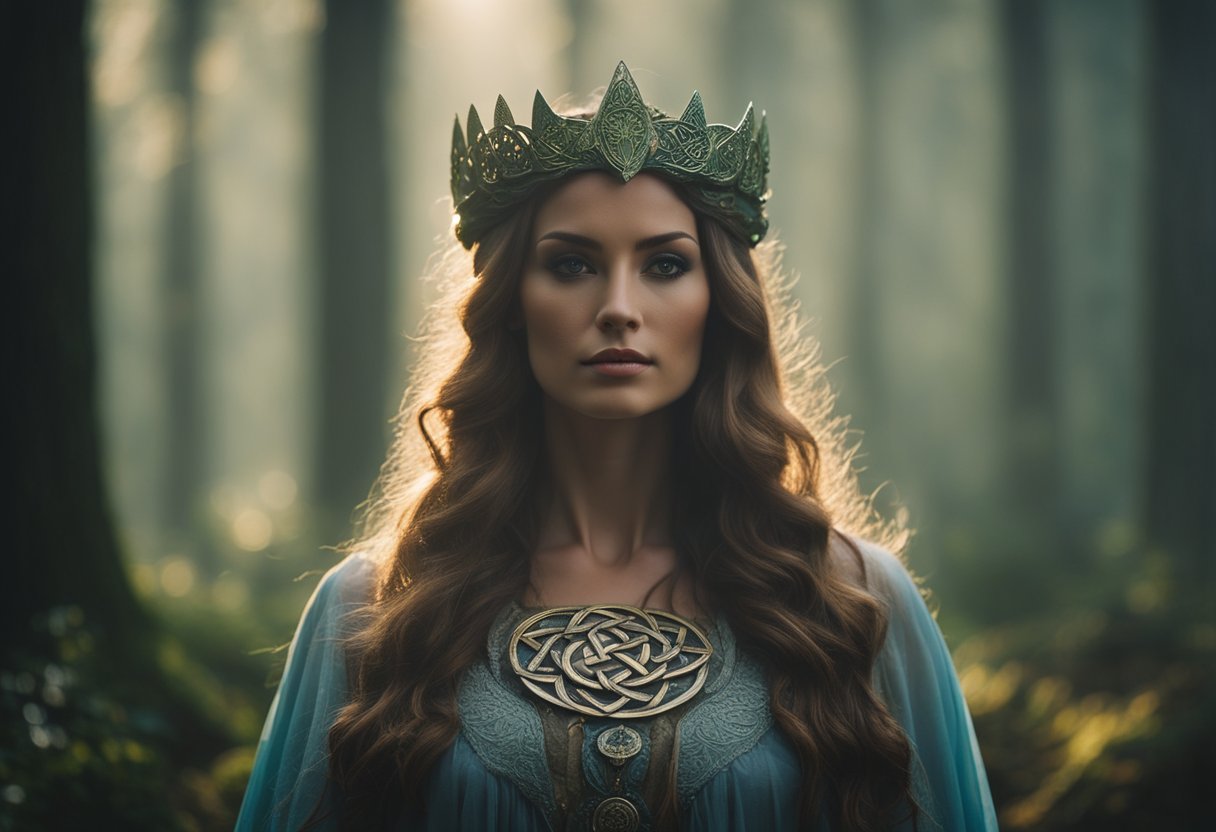
Our exploration begins with the rich tapestry of stories and characters that form the foundation of Celtic mythology. The ancient Celts left a profound legacy through their deities and mythical tales, which were deeply interwoven with the people’s cultural and spiritual life.
Celtic Gods and Goddesses
The pantheon of Celtic goddesses and Gods is diverse, with figures such as the Dagda, who embodies strength and masculinity, and Brigid, known for her attributes of healing, poetry, and smithcraft. These deities governed various aspects of life and the natural world, often associated with particular geographical features such as rivers, hills, and forests. These characters were not only worshipped but also celebrated through various rituals and festivals, which helped to cement their roles within Celtic society.
Celts and Roman Influence
The Celts’ interaction with the Roman Empire significantly affected their mythology. As the Romans expanded their empire, they came into contact with the Celtic tribes of Europe and Britain. The ensuing cultural exchange led to a degree of syncretism where Roman gods were merged with Celtic counterparts. This influence can be seen in the assimilation of Roman gods’ names and attributes with those of the Celts, such as the god Lugus, who shares similarities with the Roman Mercury. This amalgamation did not erase the unique characteristics of Celtic mythology but rather enriched its narrative, ensuring its continued relevance and evolution.
Pantheon of the Celts

Exploring the ancient Celtic pantheon, we discover a realm where deities and mythological figures are woven deeply into the fabric of nature and society. These entities encompass a variety of roles, from the nurturing earth mother to formidable warriors of the otherworld. Key figures in this pantheon include Danu, the Dagda, Lugh, and the Morrigan, each with their own distinct stories and attributes.
Mother Goddess Danu
Danu, regarded as the ultimate mother goddess, is believed to have been the matriarch of the Tuatha Dé Danann, the storied tribe of gods in Irish mythology. Embodying the earth and its fertility, Danu symbolises abundance and nurturing, which suggests her preeminent status among the Celtic deities.
The Dagda: Father Figure
Adjacent to Danu stands the Dagda, a paternal figure venerated for his prowess and benevolence. His epithet, “the good god,” is a testament to his myriad skills and virtues, which include being an adept craftsman, a formidable warrior, and a wise ruler. He holds a place of high esteem in the otherworld, symbolising the foundational balance of Danu’s maternal qualities.
Lugh of the Long Arm
Lugh, famously known as the Long Arm, shines as a multi-talented deity associated with craftsmanship, the arts, and war. His skills are legion, earning him a reputation as a master of all trades and an important figure during the Tuatha Dé Danann’s reign. Lugh’s festivals, like Lughnasadh, celebrate his gifts to humanity, notably in agriculture.
The Morrigan: War Goddess
The formidable Morrigan looms as the quintessential war goddess, not only embodying the fury and chaos of battle but also prophesying its outcome. She is known to transform into a crow, a symbol that has come to be closely associated with war. Furthermore, Morrigan’s aspects may include the goddess of healing, indicative of her complex and powerful persona within the Celtic pantheon.
Irish Deities and Sagas
In exploring the tapestries of Irish mythology, we encounter gods and goddesses whose stories are interwoven with the elements of nature and the complexities of human emotions. These mythical figures from ancient sagas have left a lasting impact on Irish cultural heritage.
Brigid: Celtic Goddess of Fire
Brigid, revered in Irish mythology, exemplifies the intertwining forces of fire, fertility, and poetry. As a patroness of healers and smiths, her flame not only represents the literal hearth but also the fires of inspiration vital to bards and craftspeople.
Aengus: God of Love and Youth
Aengus (Óengus), The Young Son, casts a charming spell over Irish sagas as the deity of love, beauty, and youth. His tales often depict the pursuit of love not merely as a fleeting desire but as a quest that demands bravery akin to the mightiest warriors.
Cernunnos: The Horned God
Cernunnos, with his antlered silhouette, emerges from the mists of Celtic belief as The Horned God. A symbol of nature’s cycles and fertility, this deity is often associated with animals and the bountiful earth, featuring prominently in narratives of hunters and the wilderness.
Celtic Underworld Deities
In the shadows of the Celtic otherworld await deities like Arawn and Donn, each presiding over realms of the departed. The Cailleach, as a divine hag associated with winter, embodies transformative power, drawing a veil between life, death, and rebirth within the cycle of the seasons.
Our exploration of these deities illuminates the values and beliefs of the Celtic peoples and highlights the influences these figures exert on modern interpretations of Irish heritage and identity.
Welsh Deities and Myth

We delve into the rich tapestry of Welsh mythology, introducing deities that represent vital aspects of life and the universe, from inspiration and wisdom to the afterlife and animal protection.
Ceridwen and the Cauldron of Inspiration
Ceridwen, a powerful enchantress in Welsh legends, is closely associated with a magical object called the Cauldron of Inspiration. This cauldron bestowed wisdom and creative inspiration upon those who tasted its brew. Ceridwen’s story is about pursuit and transformation, chasing after Gwion Bach, who became the great bard Taliesin after consuming the cauldron’s potions.
Arawn: Lord of Annwn
Arawn, the sovereign of the Welsh underworld named Annwn, is a figure shrouded in mystery and reverence. His domain was a place of departed spirits, and he often intersected with the mortal world, leading to tales of alliances and contests that tested the mettle of kings and warriors.
Epona: Protector of Horses
Although primarily associated with the continental Celtic pantheon, Epona, a deity who extends her influence into the realm of Welsh myth, embodies the protection of horses. She is revered as a guardian who ensures these esteemed animals’ safety and vitality, demonstrating the deities’ interconnectedness throughout Celtic cultures.
Celtic Goddesses of Sovereignty
Celtic mythology reveres the concept of sovereignty, often embodied by powerful female deities. These goddesses are intrinsically linked to the vitality of the land and the prosperity of the people.
Macha and the Land
Macha, a formidable goddess within the Celtic pantheon, exemplifies the profound connection between sovereignty and the Earth. Her narrative is rich with symbolism, representing not only the power and protection afforded to a ruler but also the fertility and abundance of the land itself. In the stories, her bond with the Earth is so profound that the well-being of the people and the land are seen as one and the same. Macha can bring forth great misfortune when disrespected, underlining her role as a guardian of sovereignty.
Boann and the River Boyne
Equally significant is Boann, the goddess associated with water and the River Boyne. Revered as a source of wisdom and inspiration, she is integral to the life-sustaining properties of water. The river itself, named after Boann, is not just a body of water but a symbol of life, transformation, and the flowing essence of sovereignty. As Boann interacts with the water, her influence extends beyond the physical; she encompasses the passage of time and the undercurrents of destiny that impact both rulership and the land.
The Nature of Celtic Mythology

Celtic myths are a captivating tapestry of tales that reflect the deep connection between the ancient Celts and the natural world. These stories are rich in symbolism and intertwine various elements of nature with the divine.
Animals and Sacred Creatures
In Celtic myth, animals are often revered as sacred creatures. They serve as symbols of divine forces and are integral to understanding the Celts’ perception of the world. For instance, the horse, a creature respected for its strength and grace, was associated with the sun goddess Epona. Epona was revered for protecting horses and riders, symbolising sovereignty and guidance.
Birds also held great significance, with the raven symbolising battle and prophecy. The deity often connected to the raven is the Morrígan, who is known as a goddess of war and fate. Her association with the raven underscores her role as a harbinger of doom and a manipulator of the battle’s outcome.
Rivers, Mountains, and Landscapes
Rivers, mountains, and landscapes hold a profound place in Celtic mythology. The Celts saw rivers not just as bodies of water but as divine entities. The River Shannon, for example, is linked with the goddess Sionann, and its waters were believed to offer wisdom and inspiration.
Mountains, in their towering majesty, were often viewed as the abodes of gods. The Paps of Anu in County Kerry is named after Anu, considered the mother of the Celtic gods, underscoring the sacred nature of the earth.
Celtic myths are abundant with stories that speak of the significance of the earth, often personified and imbued with the spirit of the land’s deity. This connection between the physical landscapes and the spiritual realm highlights the Celts’ reverence for nature and their belief in the sanctity of the earth, mountains, and changing weather patterns.
Celtic Festivals and Seasons
Celtic festivals mark key transitions in the annual cycle, deeply intertwined with the elements of the seasons, fertility, and death. These celebrations are rich with ancient rites connected to the agricultural calendar, where fire often symbolises the life force during summer and other seasonal quarters.
Samhain: Festival of Death and Rebirth
Samhain, pronounced ‘sow-in’, is traditionally held on 1 November, ushering in the dark half of the year. This festival heralds the end of the harvest season and the beginning of winter. As a time when the veil between worlds is believed to be at its thinnest, Samhain is a period to honour ancestors and the deceased. Ritual fires serve as a potent symbol during Samhain, representing the light within the darkness and serving as guardians against the encroaching cold.
Beltane: Fires of Fertility
Celebrated on 1 May, Beltane embodies the peak of spring and the onset of summer. The festival is closely associated with fertility, not just in the land but also within communities. Grand bonfires are central to Beltane customs—our ancestors leapt over these fires as an act of purification and to encourage growth. These fires also signify the returning strength of the sun, bringing warmth and light that nurture life across the Earth.
Celtic Symbolism and Art
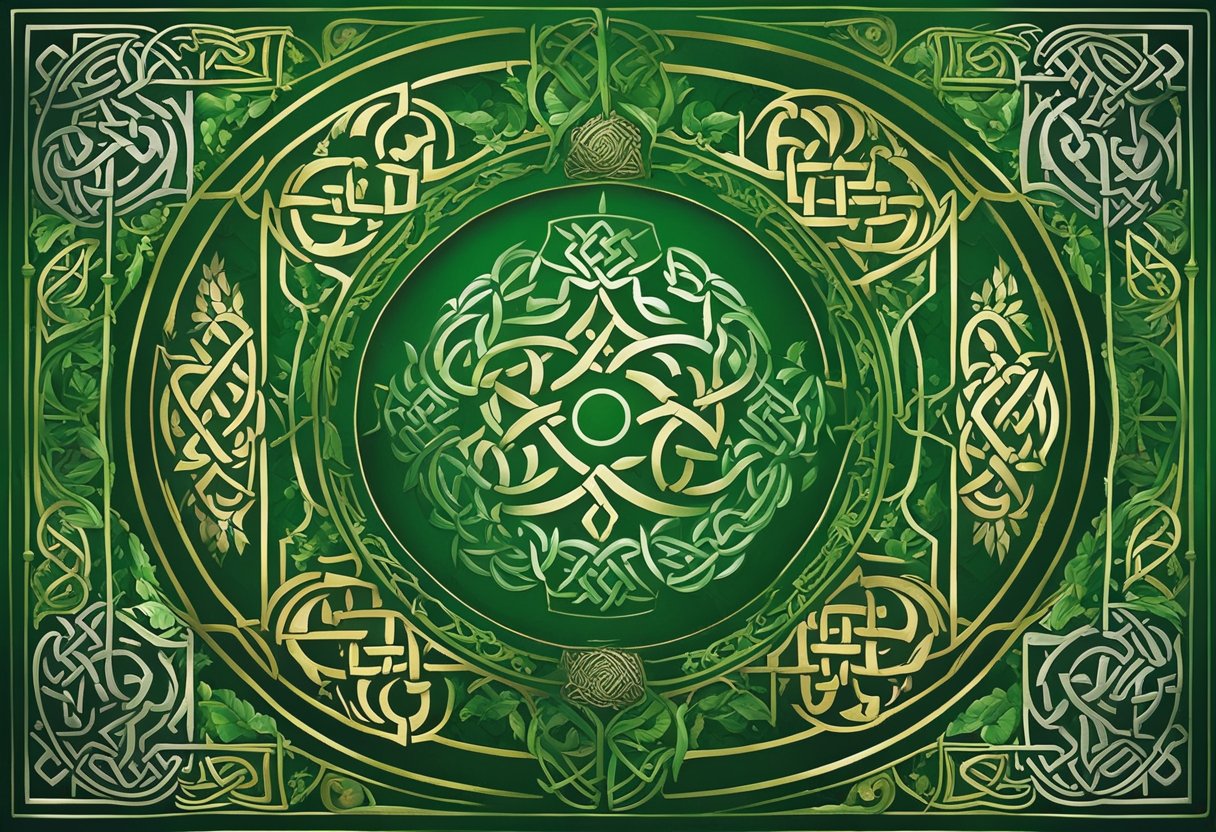
Celtic art is renowned for its intricate designs and symbolic motifs, which reflect ancient Celts’ beliefs and values. It encompasses a range of mediums, from stone carvings to stunning metalwork, and often features symbols of animals, the natural world, and mythological narratives.
Celtic Knotwork and Metalwork
The artistry of the Celts is perhaps best exemplified in their knotwork and metalwork, representing eternity and the interconnectedness of all life through never-ending loops. Celtic artists were masters of decoration, crafting objects like the Tara Brooch and the Ardagh Chalice, which display a mesmerising complexity of intertwined patterns.
Symbols of War and Protection evoke a strong sense of security and valour among the Celts. Images of the cat, associated with magic and guardianship, and the crow and raven, seen as messengers of the gods during the war, adorned their shields and weaponry. Additionally, the harp, a symbol of Ireland itself, was believed to call the spirits to war or to protect through enchantment.
Rituals and Magic in Celtic Myth
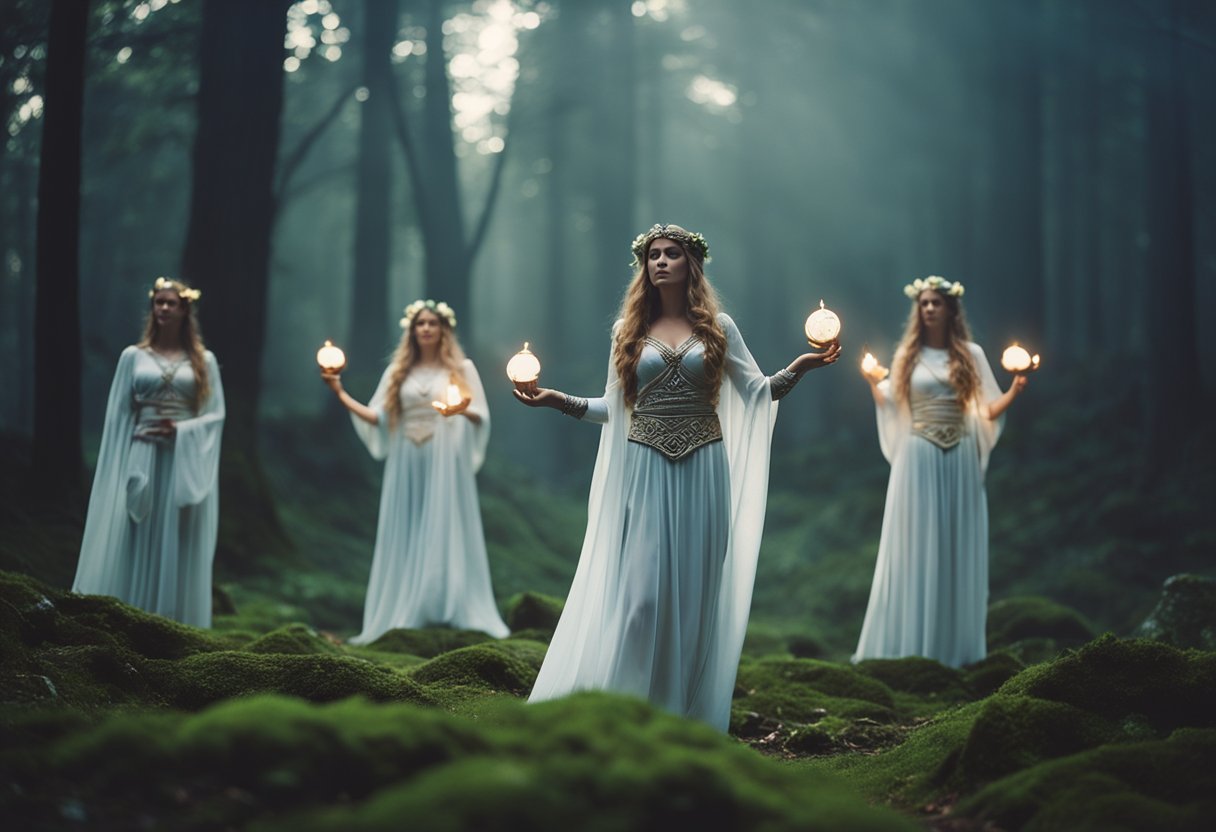
In Celtic mythology, magic and rituals were integral to the beliefs and practices of the Celts. We will uncover the significance of druidic ceremonies and the power attributed to various objects of enchantment.
Druidic Rituals
The Druids were esteemed within Celtic societies as priests, scholars, and judiciary figures. They played a crucial role in conducting rituals which were thought to harness natural and supernatural forces. One of the most enigmatic figures in this tradition was Taliesin, a figure of Welsh mythology often associated with poetry, prophecy, and magic. Outdoor settings such as groves were considered auspicious for their ceremonies. In particular, the Druids used a cauldron as a symbol and tool during these rites – a motif echoing through the tale of Taliesin, whose transformative initiation involved a magical cauldron.
Locations for Rituals:
- Natural groves
- Stone circles
- River sources
Ceremonial Objects:
- Cauldrons
- Staffs
- Robes
Talismans and Enchantments
The Celts believed that certain objects, referred to as talismans, held magical properties that could protect, heal, or harm. Amulets crafted with care were often inscribed with words of power and carried by individuals to bring about specific magical effects. The lore is replete with such objects of power that could influence the world around them, including the enchanting stories where spells were cast using the names of gods or spirits. Even today, the allure of these ancient tales and their magical objects remains a vibrant thread in the fabric of Celtic mythology.
Common Talismans:
- Amulets for protection
- Charms for healing
- Stones for divination
Enchantment Methods:
- Incantations
- Votive offerings
- Invoking deities
Adaptation and Legacy

Celtic gods and goddesses have experienced a considerable transformation through history, particularly with the advent of Christianity, which has left an indelible mark on these ancient beliefs. In contemporary society, the legacy of Celtic deities endures, influencing various cultural and artistic domains.
Christianity’s Influence on Celtic Myths
Christianity exerted a profound influence on Celtic mythology, leading to the syncretism of pagan and Christian traditions. Monks and scribes, who were among the few literate people during early medieval times, often recorded these myths. As a result, many stories of the Celtic deities were preserved but altered, with pagan gods and goddesses either Christianised into saints or demons or incorporated into Christian narratives. A notable example is Brigid, originally a Celtic fire goddess, who is said to have become St. Brigid in Christianity, with her festival of Imbolc transforming into St. Brigid’s Day.
Celtic Legacy in Modern Times
Our modern culture still reveres the Celtic gods and goddesses, keeping their stories alive through literature, festivals, and other cultural expressions. Their influence is evident in the arts, with characters and motifs from Celtic mythology appearing in everything from fantasy novels to films. Additionally, ancient celebrations such as Samhain have evolved into Halloween, blending historical traditions with contemporary festivities. This enduring presence shows that the legacy of Celtic mythology continues to play a role in shaping our cultural identity and history.
FAQ
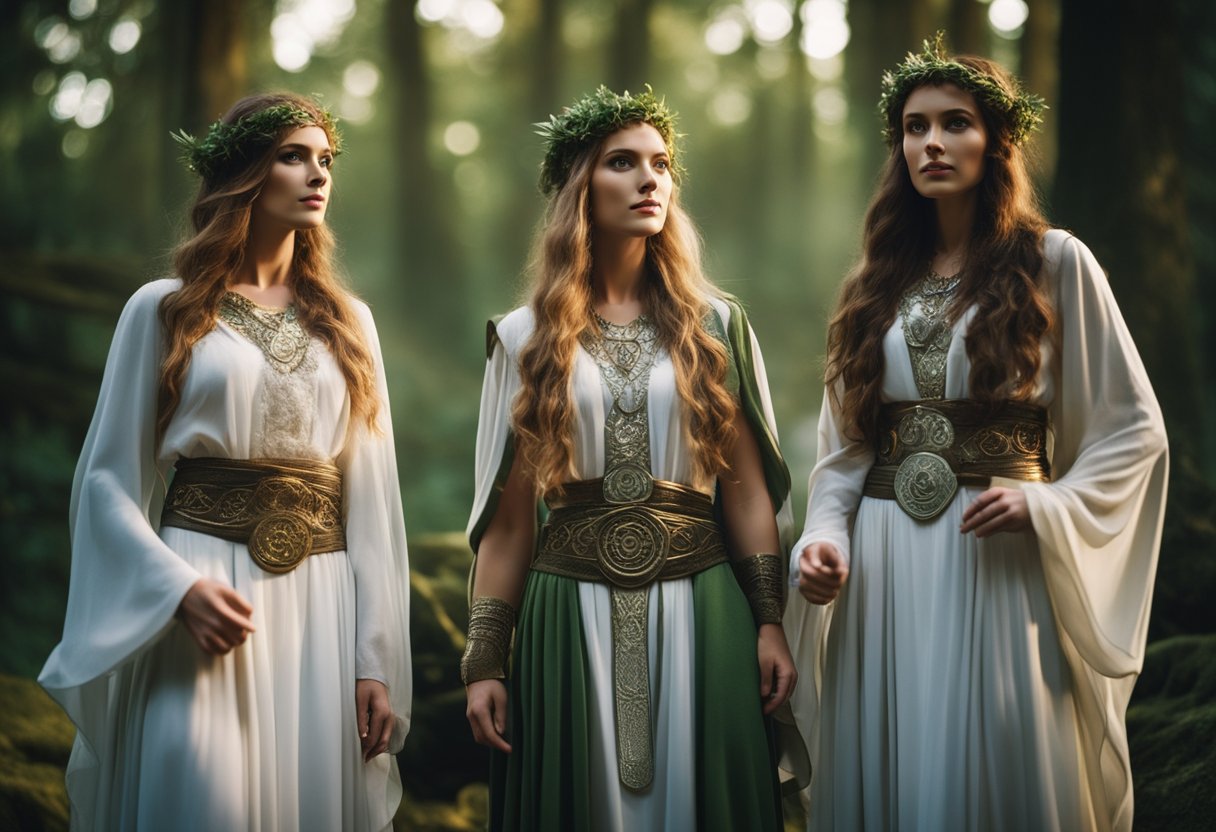
In this section, we’ll answer some of the most commonly asked questions about Celtic goddesses, exploring their power, attributes, and the stories woven around them.
Who is considered the most powerful goddess in Celtic mythology?
The Morrigan is often considered the most powerful goddess in Celtic mythology. She is revered as a figure of war and fate, depicted as a prophetess and a guardian of territory and kings.
What are the main attributes of the prominent female deities in Celtic legends?
The female deities in Celtic legends are characterised by their strong connections to nature, sovereignty, and the life cycle. For instance, Bridget is associated with healing, poetry, and smithcraft, while The Morrigan embodies war and sovereignty.
Which ancient Celtic goddess is recognised as the deity of nature and fertility?
Epona is widely recognised as the Celtic goddess of nature and fertility. She was revered as a protector of horses, donkeys, and mules and was also associated with the fertility of the land.
Can you list the names of Celtic warrior goddesses and their associated lore?
Celtic warrior goddesses include The Morrigan, who represents the destructive forces of war, and Macha, known for her connection to the land and prowess in battle. They are storied figures with tales of power, protection, and prophecy.
What symbols are commonly associated with Celtic deities, and what do they represent?
Many symbols are associated with Celtic deities, such as the triple spiral or triskele, representing the three domains of earth, sea, and sky. The Celtic cross symbolises the four directions and the unity of the elements.
Which Celtic goddess is famed for her connection to the moon and night?
In Celtic mythology, the goddess associated with the moon and night is Arianrhod. She governs over stars, fate, and the passage of time, portraying the cyclical nature of the cosmos.


